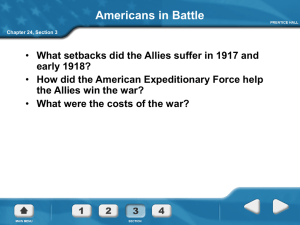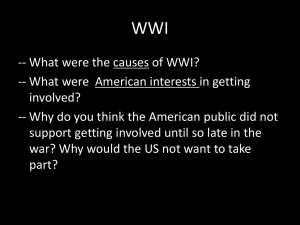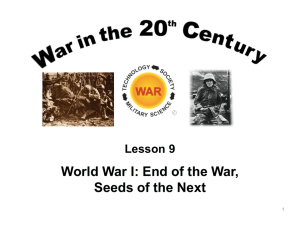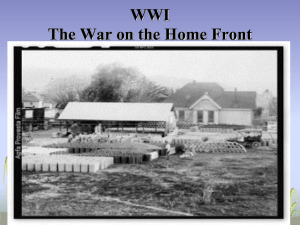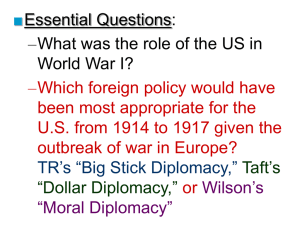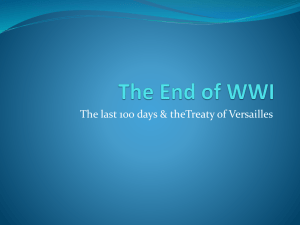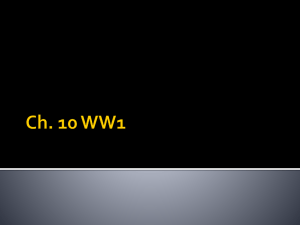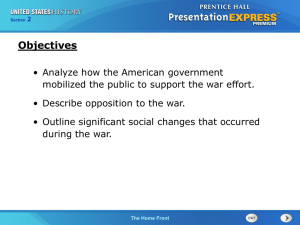L08-WarEnd
advertisement
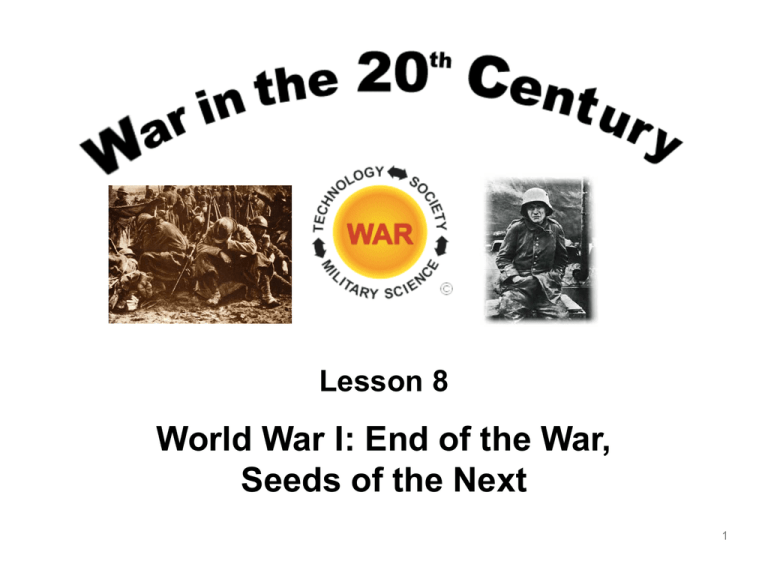
Lesson 8 World War I: End of the War, Seeds of the Next 1 Turn off cell phones! 2 Lesson Objectives • Understand the situation Germany faced as it entered 1918. • Be able to describe the changes in the war on the Western front in 1918. • Understand the role the US played in the fighting in Europe. • Be able to describe the operations of the US military in Europe in the years immediately following the armistice. • Be able to discuss the major provisions of the Versailles Treaty and how this document sowed the seeds for World War II. 3 Phases of World War I 1914 - Maneuver and Frustration 1915 - Search for New Solutions 1916 - Attrition 1917 - Desperation and Anticipation 1918 - Dénouement 4 Review of the War August 3, 1914 Germany invades Belgium; war begins Sept 5-10, 1914 “Miracle of the Marne”; German invasion halted October 1914 Race to the Sea ends; Stalemate on Western Front 1915 Feb 1915-Jan 1916 1916 Sea blockades established around UK and Germany Dardanelles Campaign (Gallipoli) Germans accept futility of breakthrough on Western Front, adopt attrition strategy against French at Verdun 5 Review of the War Feb - Dec 1916 Battle of Verdun (German Offensive) Jul - Nov 1916 Battle of the Somme (Allied Offensive) Late 1916 Germany realizes it cannot win • Adopts strategy to wear down Britain • strong defense • stormtrooper tactics • unrestricted submarine warfare 6 Review of the War Feb - Dec 1916 Battle of Verdun (German Offensive) Jul - Nov 1916 Battle of the Somme (Allied Offensive) 1 Feb 1917 German decision for unrestricted sub warfare 24 Feb 1917 Zimmerman Telegram revealed Mar 1917 6 April 1917 Germans withdraw to Hindenburg Line US declares war on Germany 7 The Yanks Are Coming! Video 8:07 8 The Commanders Enlisted for the Franco-Prussian War (1870) Commissioned from École Polytechnique 1873 Cautioned against reckless attacks in writings Corps commander in Battle of the Frontiers 1914 Appointed Supreme Commander of Allied Armies Marshal Ferdinand Foch March 26,1918 1851-1929 9 The Commanders West Point Class of 1886 Combat Experience Indian Wars Spanish-American War Philippine-American War Russo-Japanese War (observer) Mexican Punitive Expedition World War I General of the Armies John J. Pershing 1860 - 1948 Promoted by President T. Roosevelt (1905) Captain => Brigadier General Commander of the American Expeditionary Force (1917-1919) 10 The Commanders French wanted to integrate US forces into their formations Pershing insisted on US formations integrated into Allied command 11 Western Front 1917 Germans retire to Hindenburg Line Mar 1917 12 Passchendaele Third Battle of Ypres July - November 1917 British offensive Strategic Objectives Further bleed the German army Capture German submarine bases Remove German bomber threat Ghotha bomber 13 First raid June 13, 1917 Passchendaele Third Battle of Ypres July - November 1917 Battlefield was reclaimed marshland - damp in dry weather “Flanders Fields” Area experienced heaviest rains in decades as battle started Battlefield became a sea of mud 14 Passchendaele Third Battle of Ypres July - November 1917 Another bloodbath Total Casualties * UK Germany 508,800 348,300 * Numbers very controversial British commander, Field Marshal Sir Douglas Haig believed the Germans could not tolerate the losses as well as the British could Haig 15 Western Front 1917 British breakthrough at Cambrai Nov 1917 16 Eastern Front Meanwhile, … 17 Eastern Front Huge Russian losses exacerbated social unrest Tzar at the front; tzarina not able to exercise control Russian Revolution (1917) effectively took Russia out of the war Dec 15, 1917 - Russia negotiated armistice with Central Powers • Began negotiations for peace treaty one week later 18 Treaty of Brest-Litovsk March 3, 1918 Ended war between Russia & Central Powers Russia ceded large territory to Germany Most significant: One million German troops released to Western Front 19 Strumtruppen Stormtroopers Special weapons & equipment Machinegewehr 18 MG18 Schmeiser Body Armor 20 Strumtruppen Stormtroopers Bypassed strong points to attack from rear Blitzkrieg http://www.bellum.nu/basics/concepts/blitzkrieg.htm Strumtruppen http://www.worldwar1.com/arm011.htm 21 Strumtruppen Stormtroopers Major impact during Offensive of 1918 but … Too little, too late! A 22 Western Front 1917-1918 Spring Offensive ~500,000 US troops in France by March 1918 … and increasing by 300,000/month Last ditch effort by Germany German Spring Offensive March 21 - July 18, 1918 Ludendorff Offensive or Kaiserschlacht 23 Western Front 1917-1918 Final Allied Offensive Aug-Nov 1918 24 Western Front 1917-1918 Allied offensive Aug-Nov 1918 25 Americans In Europe German Spring Offensive - March-July 1918 26 Battle of Cantiny May 28, 1918 German Spring Offensive - March-July 1918 27 Battle of Cantiny May 28, 1918 First offensive action by US troops in France 28th Infantry Regiment, 1st Infantry Division (3,500 men) · Supported by French artillery, Schneider tanks US took 1,000 casualties (dead, wounded, missing) German Spring Offensive - March-July 1918 28 Battle of Belleu Wood June 1-26, 1918 German Spring Offensive - March-July 1918 29 Battle of Belleu Wood June 1-26, 1918 Allied Casualties: 1,800 dead, 8,000 wounded 2nd Division 3nd Division French, British elements 30 Battle of Belleu Wood Where legends were born 2nd Division 4th U. S. Marines Battle of Belleu Wood - June 1918 Frank Schoonover 31 Battle of Belleu Wood Battle of Belleu Wood - June 1918 32 Battle of Château-Thierry July 16, 1918 German Spring Offensive - March-July 1918 33 Battle of Château-Thierry July 16, 1918 34 Battle of Saint-Mihiel September 12-15, 1918 Allied Offensive - 1918 35 Battle of Saint-Mihiel September 12-15, 1918 36 Meuse-Argonne Offensive September 26-November 11, 1918 Allied Offensive - 1918 37 Meuse-Argonne Offensive September 26-November 11, 1918 38 Americans In Europe US soldiers escort German prisoners 39 Armistice Armistice signed at Compiègne – November 11, 1918 40 Armistice Armistice signed at Compiègne – November 11, 1918 41 Irony French surrendered at Compiègne – June 20, 1940 Same place, same railroad car 42 Occupation of Germany Allied Occupation Zones 43 Occupation of Germany U.S. artillerymen cross the Rhine River for occupation duty Late November 1918 44 The Cost of War 45 The Cost of War US Participants Deaths 4,744,000 126,000 46 The Cost of War All Nations By number of dead 47 The Cost of War All Nations By percent mobilized 48 The Cost of War Tyne Cote Cemetery (Ypres) Belgium Somme American Cemetery 49 The Cost of War Douaumont Ossuary Verdun Contains the bones of an estimated 130,000 unidentified French and German soldiers 50 Seeds of the Next War Influences on World War II Versailles Treaty Lessons of World War I Great Depression 51 Treaty of Versailles Extremely harsh conditions • Significant territorial concessions • Huge reparations • Severe limitations on military • German admission of responsibility for war 52 Treaty of Versailles Florida Holocaust Museum http://www.flholocaustmuseum.org/history_wing/thirdreich/treaty_versailles.cfm 53 Treaty of Versailles Reparations • 269 billion gold marks ( £ 24 billion) • Later reduced to 132 B gold marks ( £ 6.6 B) • Equivalent to $284 B (based on CPI)* Many feel this led to the economic collapse of the 1920’s that sewed the seeds of Fascism * 2005 54 Treaty of Versailles Military Provisions • German army restricted to 100,000 men (long term contract) • No conscription or training • No tanks or heavy artillery • Navy limited to 15,000 men • 6 small battleships, 6 cruisers, 12 destroyers, no U-boats • No air force 55 Treaty of Versailles War Guilt Clause ``The Allied and Associated Governments affirm, and Germany accepts, the responsibility of Germany and her allies for causing all the loss and damage to which the Allied and Associated Governments and their nationals have been subjected as a consequence of the war imposed upon them by the aggression of Germany and her allies.'' Article 231 56 Review of the War August 3, 1914 Germany invades Belgium; war begins Sept 5-10, 1914 “Miracle of the Marne”; German invasion halted October 1914 Race to the Sea ends; Stalemate on Western Front 1915 Feb 1915-Jan 1916 1916 Sea blockades established around UK and Germany Dardanelles Campaign (Gallipoli) Germans accept futility of breakthrough on Western Front, adopt attrition strategy against French at Verdun 57 Review of the War Feb - Dec 1916 Battle of Verdun (German Offensive) Jul - Nov 1916 Battle of the Somme (Allied Offensive) 1 Feb 1917 German decision for unrestricted sub warfare 24 Feb 1917 Zimmerman Telegram revealed Mar 1917 6 April 1917 Germans withdraw to Hindenburg Line US declares war on Germany 58 Review of the War June 1917 3 Mar 1918 First American troops arrive in France Treaty of Brest-Litovsk (Russia out of the war) 21 Mar - 18 Jul 1918 Germans Spring Offensive 8 Aug - 11 Nov 1918 Allies’ Hundred Days Offensive 11 Nov 1918 Armistice 28 Jun 1919 Treaty of Versailles signed 59 Review of World War I Animated Maps Start Animation ( 6:43 ) 60 Phases of World War I 1914 - Maneuver and Frustration 1915 - Search for New Solutions 1916 - Attrition 1917 - Desperation and Anticipation 1918 - Dénouement 61 What Would Weinberger Do? How would US decision to enter World War I have stood up against the test of the Weinberger Doctrine? Vital to our national interest? Clear intent to win? Clearly defined political & military objectives? Objectives, forces committed continuously reassessed? Support of the American people? Last resort? 62 Lesson 9 The Interwar Years: Preparing for the Next War Lesson Objectives • Understand the major military lessons that each of the major combatants (Britain, France, US, Germany and Russia) took from World War I. • Be able to describe and discuss the steps that each major combatant took to "prepare for the next war." • Understand the military revolution that occurred during the interwar years. • Be able to recount the major events in the 1930's that lead to war in Europe and the Pacific. Building Support Chorus Over there, over there, Send the word, send the word over there That the Yanks are coming, The Yanks are coming, The drums rum-tumming Ev'rywhere. So prepare, say a pray'r, Send the word, send the word to beware. We'll be over, we're coming over, And we won't come back till it's over Over there Billy Murray - audio Arthur Fileds - video Nora Bayes - video End 66
